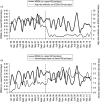Impact of an enhanced antibiotic stewardship on reducing methicillin-resistant Staphylococcus aureus in primary and secondary healthcare settings
- PMID: 23735079
- PMCID: PMC9151142
- DOI: 10.1017/S0950268813001374
Impact of an enhanced antibiotic stewardship on reducing methicillin-resistant Staphylococcus aureus in primary and secondary healthcare settings
Abstract
The objective of this study was to evaluate the impact of restricting high-risk antibiotics on methicillin-resistant Staphylococcus aureus (MRSA) incidence rates in a hospital setting. A secondary objective was to assess the impact of reducing fluoroquinolone use in the primary-care setting on MRSA incidence in the community. This was an interventional, retrospective, ecological investigation in both hospital and community (January 2006 to June 2010). Segmented regression analysis of interrupted time-series was employed to evaluate the intervention. The restriction of high-risk antibiotics was associated with a significant change in hospital MRSA incidence trend (coefficient=-0·00561, P=0·0057). Analysis showed that the intervention relating to reducing fluoroquinolone use in the community was associated with a significant trend change in MRSA incidence in community (coefficient=-0·00004, P=0·0299). The reduction in high-risk antibiotic use and fluoroquinolone use contributed to both a reduction in incidence rates of MRSA in hospital and community (primary-care) settings.
Figures


References
-
- Lindsay JA, Holden MT. Staphylococcus aureus: superbug, super genome? Trends in Microbiology 2004; 12: 378–385. - PubMed
-
- Wilcox MH, Dave J. The cost of hospital-acquired infection and the value of infection control. Journal of Hospital Infection 2000; 45: 81–84. - PubMed
-
- Gould IM. The clinical significance of methicillin-resistant Staphylococcus aureus. Journal of Hospital Infection 2005; 61: 277–282. - PubMed
-
- Coia JE, et al. Guidelines for the control and prevention of meticillin-resistant Staphylococcus aureus (MRSA) in healthcare facilities. Journal of Hospital Infection 2006; 63 (Suppl. 1): S1–44. - PubMed
MeSH terms
Substances
LinkOut - more resources
Full Text Sources
Other Literature Sources
Medical

